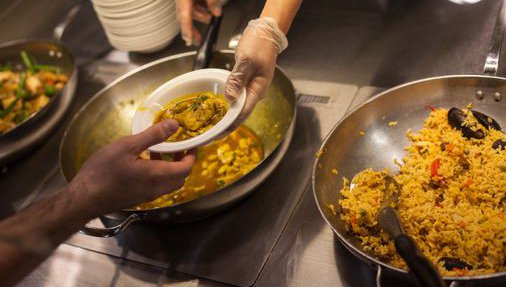Connecting Cafeterias to Culture and the Classroom
Serving culturally relevant seafood meals in schools.
In collaboration with South Portland Public Schools, Westbrook Public Schools, Chef Samantha Cowens-Gasbarro, and community consultant, Khadija Ahmed, we are building demand for and increasing consumption of local seafood in K-12 schools. This project creates culturally diverse recipes, develops seafood-focused curricula, trains food service staff on the how and why of serving local seafood, and facilitates the purchase of local seafood by cafeterias.

Project Goals:
- Develop culturally diverse local fish recipes to provide immigrant students and students from diverse backgrounds with familiar flavors and preparations.
- Connect what’s being served in the cafeteria to what students are learning in the classroom by developing local seafood curricula.
- Empower food service staff to be proud of the difficult and often under-appreciated labor of providing students with healthy, nutritious local seafood.
- Provide public school students access to an incredibly nutritious source of local protein.
- Build demand for regional seafood to support fishermen, working waterfronts, and coastal communities.
Why local seafood?
Seafood is New England’s most abundant and healthiest source of protein. However, across the region, less than 1/3 of K-12 schools are serving local seafood, missing an opportunity to provide students with a variety of health benefits. We also know that the majority of local seafood is responsibly harvested and can often be a climate-friendly protein option. At the same time, New England fishermen are competing with seafood from across the globe and are working to build and maintain market access in the region. Building institutional demand is crucial to ensuring that New England harvesters can continue to thrive.
Why culturally diverse seafood recipes?
- Provide familiar preparations of a familiar protein to students from parts of the world that consume much more seafood.
- Add a halal-suitable menu option.
- Educate students from all backgrounds about the diversity of Gulf of Maine seafood.
- Offer a healthy local protein option.

Why staff training?
We’ve seen success in sea-to-school projects when food service staff are engaged, excited, and proud of serving local seafood. The aim of training food service staff is to provide education on both how to prepare seafood and the many benefits that come along with serving local seafood, so cafeteria staff feel empowered and proud to serve it to their students.

Why seafood education?
This project seeks to ensure that schools are successful in serving seafood so that they put it on the menu more often. Connecting to the classroom and providing seafood education is critical to building buy-in among students and educating them on local seafood’s impact s on our health, environment, and communities. This is why we partnered with teachers to co-develop seafood curricula to forge that important classroom-to-cafeteria connection. View the curriculum here.
Local Seafood in Maine Schools
People throughout the region are working together on Sea to School partnerships in order to get more seafood into school cafeterias. This curriculum module, developed with support from the Henry P. Kendall Foundation, focuses on the importance of seafood across communities and cultures and celebrates its environmental, economic, and nutritional benefits.
Project Team:
Project Sponsor
This project is possible thanks to generous support from the Henry P. Kendall Foundation.
Read More
-
Skillin Elementary connects cafeterias to culture and the classroom
Recently, at Waldo T. Skillin Elementary School, chef Khadija Ahmed introduced culturally diverse dishes featuring locally sourced seafood as part of the Gulf of Maine …
Press Clips
-
2022 Sustainable Seafood Impact Report
We want to keep you updated on our sustainable seafood team's progress, so we've developed a report showcasing some of their biggest achievements from 2022.
Announcements
-
Publix, Ahold highlight new sustainable products and initiatives during Earth Month
U.S. grocery chains featuring new sustainable and traceable seafood.
Press Clips
-
At college campuses, it’s Sustainable Seafood 101 - The Boston Globe
By engaging college students, campus chefs and seafood marketers hope to create future buyers.
Press Clips




